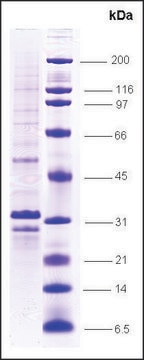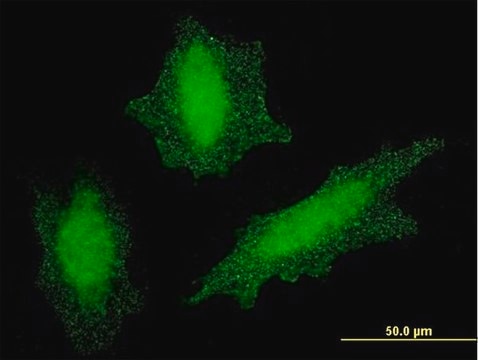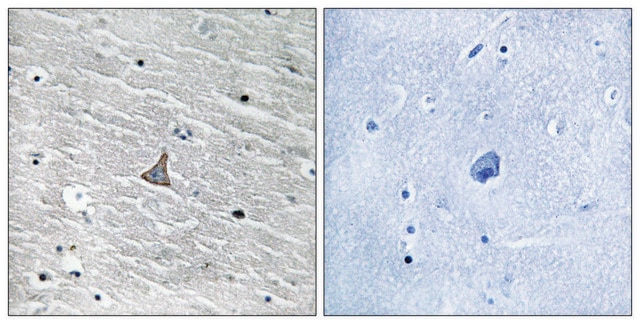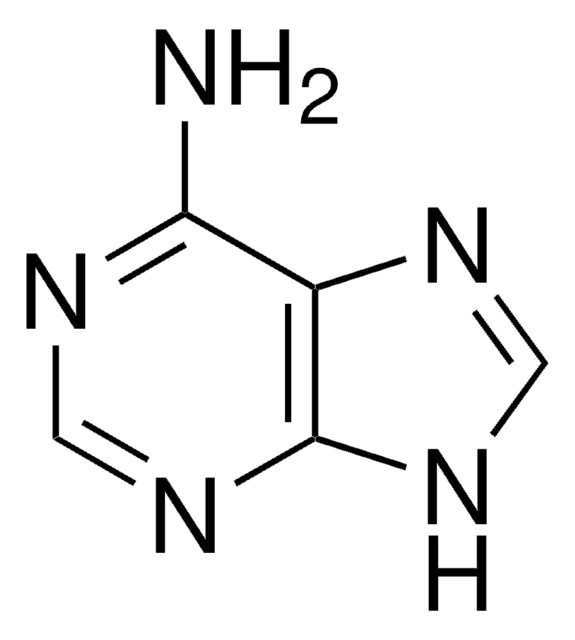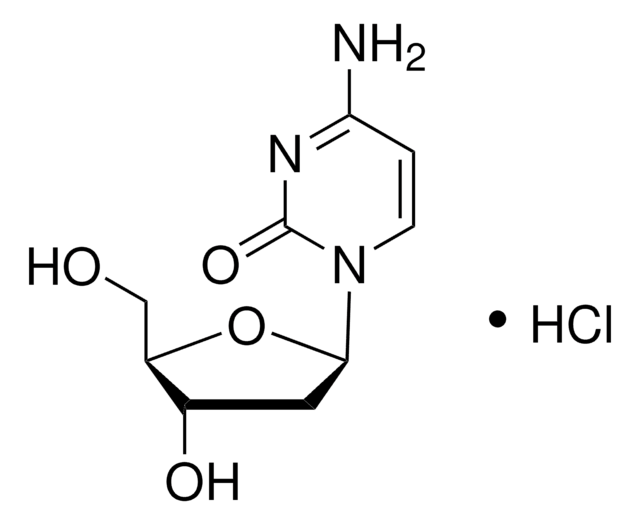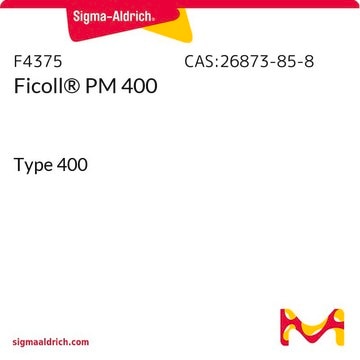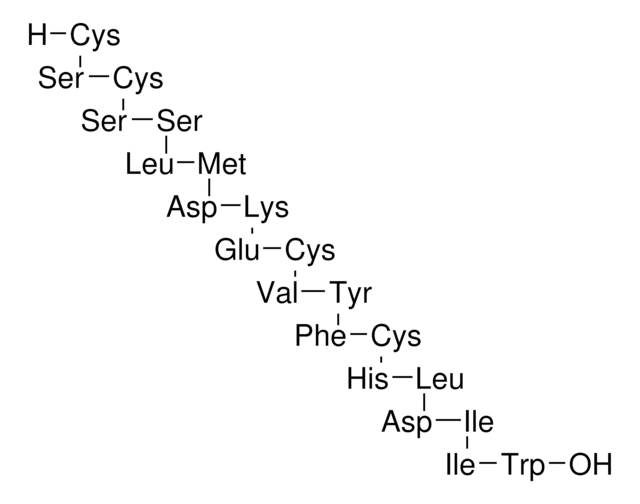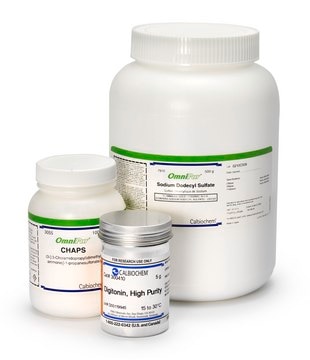General description
We are committed to bringing you greener alternative products, which adhere to one or more of The 12 Principles of Green Chemistry. This antibody is Preservative-free, produced without the harm or sacrifice of animals and exceptionally stable to allow for ambient shipping and storage if needed and thus aligns with "Waste Prevention", "Designing Safer Chemicals" and "Design for Energy Efficiency".
Click here for more information.
ZooMAb® antibodies represent an entirely new generation of recombinant monoclonal antibodies. Each ZooMAb® antibody is manufactured using our proprietary recombinant expression system, purified to homogeneity, and precisely dispensed to produce robust and highly reproducible lot-to-lot consistency. Only top-performing clones are released for use by researchers. Each antibody is validated for high specificity and affinity across multiple applications, including its most commonly used application. ZooMAb® antibodies are reliably available and ready to ship when you need them.
Specificity
Clone 1C10 is a ZooMAb® rabbit recombinant monoclonal antibody that specifically detects von Hippel-Lindau disease tumor suppressor (VHL). It targets an epitope within 25 amino acids from the internal region.
Immunogen
KLH-conjugated linear peptide corresponding to 25 amino acids from the internal region of human von Hippel-Lindau disease tumor suppressor (VHL).
Application
Quality Control Testing
Evaluated by Western Blotting in Raji cell lysate.
Western Blotting Analysis: A 1:1,000 dilution of this antibody detected VHL in Raji cell lysate.
Tested Applications
Western Blotting Analysis: A 1:1,000 dilution from a representative lot detected VHL in HEK293 and MCF-7 cell lysates.
Immunohistochemistry (Paraffin) Analysis: A 1:1,000 dilution from a representative lot detected VHL in Human colon tissue sections and 1:100 dilution detected VHL in Human testis tissue sections.
Affinity Binding Assay: A representative lot of this antibody bound VHL peptide with a KD of 7.7 x 10-8 in an affinity binding assay.
Immunocytochemistry Analysis: A 1:100 dilution from a representative lot detected VHL in HEK293 cells.
Note: Actual optimal working dilutions must be determined by end user as specimens, and experimental conditions may vary with the end user.
Target description
von Hippel-Lindau disease tumor suppressor (UniProt: P40337; also known as Protein G7, pVHL) is encoded by the VHL gene (Gene ID: 7428) in human. VHL is a component of the VCB (VHL-Elongin BC-CUL2) complex that acts as a substrate recognition component of a ubiquitin-ligase E3 and directs proteasome-dependent degradation of targeted proteins. VHL interacts with CUL2, and this interaction is dependent on the integrity of the trimeric VCB complex. It targets recruitment subunit in the E3 ubiquitin ligase complex and recruits hydroxylated hypoxia-inducible factor (HIF) under normoxic conditions. It is involved in transcriptional repression through interaction with HIF1α and histone deacetylases. In addition to oxygen-related gene expression, VHL plays a role in cilia formation, cytokine signaling, regulation of senescence, and formation of the extracellular matrix. It is reported to be essential for embryonic and placental development. Its inactivation results in embryonic death from abnormal placental vascularization. Murine models with VHL deficiency develop syncytiotrophoblasts and labyrinths and display hemorrhage by embryonic day 11.5 to 12.5. Three isoforms of VHL have been described that are produced by alternative splicing and alternative initiation. Isoform 1 is predominantly cytoplasmic with some expression in the nucleus and membrane, whereas isoform 3 is equally distributed between the nucleus and cytoplasm and is not observed in the cell membrane. Mutations in VHL gene have been linked to von Hippel-Lindau syndrome, pheochromocytoma, erythrocytosis, and renal cell carcinoma. This ZooMAb® recombinant monoclonal antibody, generated by our propriety technology, offers significantly enhanced specificity, affinity, reproducibility, and stability over conventional monoclonals. (Ref.: Haase, VH. (2009). Curr. Pharm. Des. 15(33); 3895-3903; Kaelin, WG. (2008). Nat. Rev. Cancer. 8; 865-873; Tanimoto, K., et al. (2000). EMBO J. 19(16); 4298-4309).
Physical form
Purified recombinant rabbit monoclonal antibody IgG, lyophilized in PBS, 5% Trehalose, normal appearance a coarse or translucent resin. The PBS/trehalose components in the ZooMAb formulation can have the appearance of a semi-solid (bead like gel) after lyophilization. This is a normal phenomenon. Please follow the recommended reconstitution procedure in the data sheet to dissolve the semi-solid, bead-like, gel-appearing material. The resulting antibody solution is completely stable and functional as proven by full functional testing. Contains no biocide or preservatives, such as azide, or any animal by-products. Larger pack sizes provided as multiples of 25 µL.
Reconstitution
300 µg/mL after reconstitution at 25 µL per vial. Please refer to guidance on suggested starting dilutions and/or titers per application and sample type.
Storage and Stability
Recommend storage of lyophilized product at 2-8°C; Before reconstitution, micro-centrifuge vials briefly to spin down material to bottom of the vial; Reconstitute each vial by adding 25 µL of filtered lab grade water or PBS; Reconstituted antibodies can be stored at 2-8°C, or -20°C for long term storage. Avoid repeated freeze-thaws.
Other Notes
Concentration: Please refer to the Certificate of Analysis for the lot-specific concentration.
Legal Information
ZooMAb is a registered trademark of Merck KGaA, Darmstadt, Germany
Disclaimer
Unless otherwise stated in our catalog or other company documentation accompanying the product(s), our products are intended for research use only and are not to be used for any other purpose, which includes but is not limited to, unauthorized commercial uses, in vitro diagnostic uses, ex vivo or in vivo therapeutic uses or any type of consumption or application to humans or animals.

